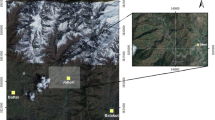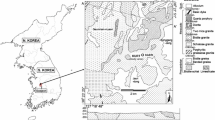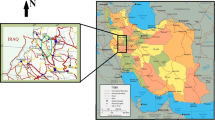Abstract
Squeezing problems were observed during the initial stages of excavating the Suruç tunnel which is Turkey’s longest and the world’s fifth longest irrigation tunnel at a length of 17.2 km. The tunnel is built to serve irrigation needs in the Suruç Plain. This research included prediction of squeezing potential along the Suruç tunnel. The diameter of the excavation is 7.9 m, and the final diameter of the tunnel will be 7 m. The tunnel runs mainly through formations of limestone and marl. Field studies included rock mass characterization (using the RMR, RMI, Q, GSI, and RMQR systems), discontinuity surveying, core drilling, and sampling for laboratory testing. Rock mass parameters were calculated using empirical equations. Empirical and semi-empirical approaches were used for evaluation of the squeezing potential. The convergence-confinement method and Plaxis 8.2 software were used for estimation of critical strain, tunnel support pressure, and tunnel convergence. Finally, squeezing potentials were estimated for all geological units. Localized squeezing risks were found in the tunnel. The performance of the new rock mass classification system, RMQR, to estimate the rock squeezing risks was also examined. Observations during the excavation indicated that predictions of the new squeezing risk regions were successful.






Similar content being viewed by others
References
Agan C, Yesilnacar MI, Genis M, Kulaksiz S, Ulusay R, Aydan O, Yucel MD (2013) A preliminary geoengineering assessment of Bazda antique underground quarries in Şanlıurfa, Turkey. In: Proceeding book of the ISRM international symposium: rock mechanics for resources, energy, and environment (EUROCK 2013). Wroclaw, Poland, September 2013, pp 93–98
ASTM D2487–11 (2011) Standard practice for classification of soils for engineering purposes, unified soil classification system (USCS). ASTM International, USA
Aydan O (1989) The stabilization of rock engineering structures by rockbolts. Ph.D. Thesis, Nagoya University, p 240
Aydan O (2011) Some issues in tunneling through rock mass and their possible solutions. In: Proceedings of the first Asian tunnelling conference, ATS-15, pp 33–44
Aydan O, Dalgic S (1998) Prediction of deformation behavior of 3 lanes Bolu tunnels through squeezing rocks of North Anatolian Fault Zone (NAFZ). Proceedings of the regional symposium on sedimentary rock engineering, Taipei, pp 228–233
Aydan O, Ersen A (1985) Estimation of pressures acting on the supports of mine shafts and roadways (in Turkish). Kaya Mekaniği Bülteni, TSRM 1(3):21–34
Aydan O, Genis M (2003) Silindirik ve küresel açıklıklar çevresindeki gerilme ve birim deformasyon alanlarının belirlenmesi için birleştirilmiş analitik çözüm (in Turkish). Kaya Mekaniği Bülteni, Türk Ulusal Kaya Mekaniği Derneği, Ankara, No. 15, pp 11–26
Aydan O, Genis M (2010) A unified analytical solution for stress and stress fields about radially symmetric openings in elasto-plastic rock with the consideration of support system and long-term properties of surrounding rock. Int J Min Miner Process 1(1):1–32
Aydan O, Pasamehmetoglu G (1994) In-situ measurements and lateral stress coefficients in various parts of the earth. Kaya Mekaniği Bülteni 10:1–17
Aydan O, Akagi T, Kawamoto T (1993) The squeezing potential of rocks around tunnels; theory and prediction. Rock Mech Rock Eng 26(2):137–163
Aydan O, Akagi T, Ito T, Ito J, Sato J (1995) Prediction of deformation behaviour of a tunnel in squeezing rock with time-dependent characteristics. Numerical models in geomechanics NUMOG V, pp 463–469
Aydan O, Akagi T, Kawamoto T (1996) The squeezing potential of rock around tunnels: theory and prediction with examples taken from Japan. Rock Mech Rock Eng 29:125–143
Aydan O, Ulusay R, Kawamoto T (1997) Assessment of rock mass strength for underground excavations. Int J Rock Mech Min Sci 34(3/4):777–786
Aydan O, Dalgıç S, Kawamoto T (2000) Prediction of squeezing potential of rocks in tunneling through a combination of an analytical method and rock mass classifications. Ital Geotech J 34(1):41–45
Aydan O, Tokashiki N, Genis M (2012) Some considerations on yield (failure) criteria in rock mechanics ARMA 12-640, 46th US Rock Mechanics/Geomechanics Symposium, Chicago, pp 640–650
Aydan O, Ulusay R, Tokashiki N (2013) A new rock mass quality rating system: rock mass quality rating (RMQR) and its application to the estimation of geomechanical characteristics of rock masses. Rock Mech Rock Eng. doi:10.1007/s00603-013-0462-z
Barla G (1995) Tunnelling under squeezing rock conditions. Department of Structural and Geotechnical Engineering, Politecnico di Torino
Barton N (2000) TBM tunnelling in jointed and faulted rock. Balkema, Rotterdam, p 169
Barton N (2002) Some new Q-value correlations to assist in site characterization and tunnel design. Int J Rock Mech Min Sci 39(1):185–216
Barton N, Grimstad E (1994) The Q-system following twenty years of application in NMT support selection. Felsbau 12(6):428–436
Barton NR, Lien R, Lunde J (1974) Engineering classification of rock masses for the design of tunnel support. Rock Mech 4:189–239
Bhasin R, Grimstad E (1996) The use of stress–strength relationships in the assessment of tunnel stability. Tunn Undergr Space Technol 11(1):93–98
Bieniawski ZT (1973) Engineering classification of jointed rock masses. Trans S Afr Inst Civ Eng 15:335–344
Bieniawski ZT (1978) Determining rock mass deformability: experience from case histories. Int J Rock Mech Min Sci Geomech Abstr 15:237–247
Bieniawski ZT (1989) Engineering rock mass classifications. Wiley, New York, p 251
Bonini M, Lancellotta G, Barla G (2013) State of stress in tunnel lining in squeezing rock conditions. Rock Mech Rock Eng 46:405–411
Carranza-Torres C, Fairhurst C (1999) The elasto-plastic response of underground excavations in rock masses that satisfy the Hoek–Brown failure criterion. Int J Rock Mech Min Sci 36:777–809
Carranza-Torres C, Fairhurst C (2000) Application of the convergence–confinement method of tunnel design to rock masses that satisfy the Hoek–Brown failure criterion. Tunn Undergr Space Technol 15(2):187–213
Coulomb CA (1776) Essai sur une application des regles des maximis et minimis a quelquels problemesde statique relatifs, a la architecture. Mem Acad Roy Div Sav 7:343–87
Czerewko MA, Cripps JC (2001) Assessing the durability of mudrocks using the modified jar slake index test. Q J Eng Geol Hydrogeol 34:153–163
Deere DU (1968) Geological consideration. In: Stagg KG, Zienkiewicz OC (eds) Rock mechanics in engineering practice. Wiley, London
Dube AK (1993) Squeezing under high stress conditions, assessment and prevention of failure phenomena in rock engineering. In: AK et al (ed) Pasamehmetoglu, Balkema, Rotterdam
ERD (Earthquake Research Department) (1996). http://www.deprem.gov.tr
Fenner R (1938) Untersuchungen zur Erkenntnis des Gebirgsdruckes. Gluckauf, vol 74, pp 681–695
Goel RK (1994) Correlations for predicting support pressures and closures in tunnels. Ph.D. thesis, Nagpur University, Nagpur, India, p 308
Goel RK, Jethwa JL, Paithakan AG (1995a) Tunnelling through the young Himalayas- a case history of the Maneri-Uttarkashi power tunnel. Eng Geol 39(1–2):31–44
Goel RK, Jethwa JL, Paithankar AG (1995b) Indian experiences with Q and RMR systems. Tunn Undergr Space Technol 10(1):97–109
Gong QM, Yin LJ, She QR (2013) TBM tunneling in marble rock masses with high in situ stress and large groundwater inflow: a case study in China. Bull Eng Geol Environ 72:163–172
Grimstad E, Barton N (1993) Updating the Q-system for NMT. In: Proceedings of the international symposium on sprayed concrete, Fagernes, Norway, Norwegian Concrete Association, Oslo, p 20
Hoek E, Brown ET (1997) Practical estimates of rock mass strength. Int J Rock Mech Min Sci Geomech Abstr 27 (3):227–229
Hoek E, Brown ET (1998) Practical estimates of rock mass strength. Int J Rock Mech Min Sci 34(8):1165–1186
Hoek E, Diederichs MS (2006) Empirical estimation of rock mass modulus. Int J Rock Mech Min Sci 43(2):203–215
Hoek E, Marinos P (2000) Predicting tunnel squeezing. Tunnels and tunnelling international. Part 1-November 2000, Part 2 December 2000, pp 1–21
Hoek E, Kaiser PK, Bawden WF (1995) Support of underground excavations in hard rock. Balkema, Roterdam, p 213
Hoek E, Marinos P, Benissi M (1998) Applicability of the geological strength index (GSI) classification for very weak and sheared rock masses: the case of the Athens schist formation. Bull Eng Geol Environ 57:151–160
ISRM (International Society for Rock Mechanics) (2007) The complete ISRM suggested methods rock characterization, testing and monitoring: 1974–2006, In: Ulusay R, Hudson JA, ISBN: 978-975-93675-4-1, Kozan Ofset, Ankara, Turkey, p 613
Jaky J (1948) Pressure in soils. In: Proceedings of the 2nd international conference on soil mechanics and foundation engineering. Rotterdam, The Netherlands 1, p 103–7
Jiang Q, Jiang Y, Cui J, Feng X (2014) Application of computerized tomographic scanning to the study of water-induced weakening of mudstone. Bull Eng Geol Environ 73:1293–1301
Jethwa JL, Singh B, Singh B (1984) Estimation of ultimate rock pressure for tunnel linings under squeezing rock conditions—a new approach. In: Brown ET, Hudson JA (eds) Design and performance of underground excavations. ISRM Symposium, Cambridge, pp 231–238
Kalamaris GS, Bieniawski ZT (1995) A rock mass strength concept for coal incorporating the effect of time. Proceedings of the eighth international congress on rock mechanics, vol 1, Balkema, Rotterdam, 295–302
Khanlari G, Meybodi RG, Mokhtari E (2012) Engineering geological study of the second part of water supply Karaj to Tehran tunnel with emphasis on squeezing problems. Eng Geol 145–146:9–17
Mayne PW, Kulhawy FH (1982) Ko-OCR relationships in soil. J Geotech Eng 108(GT6):851–872
Mitri HS, Edrissi R, Henning J (1994) Finite element modeling of cable-bolted slopes in hard rock underground mines. SME annual meeting 14–17 February, New Mexico. SME, Albuquerque, pp 94–116
Muirwood AM (1972) Tunnels for roads and motorways. Q J Eng Geol 5:119–120
Nakano R (1979) Geotechnical properties of mudstone of neogene tertiary in Japan. In: Proceedings of the international symposium soil mechanics, Oaxaca, pp 75–92
Nicholson GA, Bieniawski ZT (1990) A non-linear deformation modulus based on rock mass classification. Int. J. Mining and Geological Engineering 8:181–202
Palmstrom A (1995) RMi—a rock mass characterization system for rock engineering purposes. PhD Thesis, Oslo University, Norway, p 400
Palmstrom A (1996) Characterizing rock masses by the RMI for use in practical rock engineering: Part 1: the development of the Rock Mass Index (RMI). Tunn Undergr Space Technol 11(2):175–188
Palmstrom A (2000) Recent developments in rock support estimates by the RMi. J Rock Mech Tunn Technol 6(1):1–19
Plaxis BV (2000) User manual for Plaxis 8.2. Computerlaan 14, 2628 XK Delft, The Netherlands
Ramamurthy T (1986) Stability of rock mass. Indian 8th geotech society annual lecture. Indian Geotech J 16(1):1–74
Rankine WJM (1857) On the stability of loose earth. Philosophical transactions. Royal Society, London
Read SAL, Richards LR, Perrin ND (1999) Applicability of the Hoek–Brown failure criterion to New Zealand greywacke rocks. Proceeding 9th international society for rock mechanics congress, Paris, vol 2, pp 655–660
Rummel F (1986) Stresses and tectonics of the upper continental crust- a review, in Proceedings of the international symposium on rock stress and rock stress measurements, Stockholm, Centek Pubel, Lulea, pp 86–177
Saari K (1982) Analysis of plastic deformation (squeezing) of layers intersecting tunnels and shafts in rock. Ph.D. thesis, University of California, Berkeley
Serafim JL, Pereira JP (1983) Considerations of the geomechanics classification of Bieniawski. Proceedings international symposium engineering geology and underground construction, vol 1. Balkema, Rotterdam, pp 1133–1142
Sheorey PR (1997) Empirical rock failure criteria. Balkema, Rotterdam
Singh B, Jethwa JL, Dube AR (1992) Correlation between observed support pressure and rock mass quality. Tunn Undergr Space Technol 7(1):59–74
Singh B, Viladkar MN, Samadhiya NK, Mehrota VK (1997) Rock mass strength parameters mobilized in tunnels. Tunn Undergr Space Technol 12(1):47–54
Sonmez H, Ulusay R (1999) Modifications to the geological strength index (GSI) and their applicability to stability of slopes. Int J Rock Mech Min Sci 36(6):219–233
Sonmez H, Ulusay R (2002) A discussion on the Hoek–Brown failure criterion and suggested modifications to the criterion verified by slope stability case studies. Yerbilimleri 26:77–99
Tanimoto C (1984) NATM-1 (in Japanese). Morikita Shuppan, pp 168–175
Taylor RK, Spears DA (1970) The breakdown of British coal measure rocks. Int J Rock Mech Min Sci 7(5):481–501
Terzaghi K (1946) Rock defects and load on tunnel supports. Introduction to rock tunneling with steel support, a book by Proctor, RV and White, TL, Commercial Sheering and Stamping Co., Youngstown, Ohio, USA
Trueman R (1998) An evaluation of strata support techniques in dual life gateroads. PhD thesis, University of Wales, Cardiff. In: Read SAL, Richards, LR, and Perrin ND, 1999. Applicability of the Hoek–Brown failure criterion to New Zealand greywacke rocks. Proceeding 9th International Society for Rock Mechanics Congress, Paris, 2, pp 655–660
Turgut P, Yesilnacar MI, Bulut H (2008) Physico-thermal and mechanical properties of Sanliurfa limestone, Turkey. Bull Eng Geol Environ 67:485–490
Ulusay R, Sonmez H (2002) Kaya kütlelerinin mühendislik özellikleri (in Turkish), TMMOB Jeoloji Mühendisleri Odası Yayınları, No: 60, Ankara
Verman MK (1993) Rock mass-tunnel support interaction analysis. PhD Thesis, University of Roorkee, Roorkee, India
Vu TM, Monin N, Sulem J, Lascols J, Subrin D (2013) Anisotropic closure in squeezing rocks: the example of Saint-Martin-la-Porte access gallery. Rock Mech Rock Eng 46:231–246
Wiesmann E (1912) Mountain pressure. Switz J Struct 60 (7) (in German)
Wroth CP (1972) General theories of earth pressure and deformation. In: Proceedings of the 5th European conference on soil mechanics and foundation engineering. Madrid, Spain, vol 2, p 33–52
Yesilnacar MI, Cetin H (2008) An environmental geomorphologic approach to site selection for hazardous wastes. Environ Geol 55:1659–1671
Acknowledgments
The author expresses his thanks to Serkan Erturk at the State Hydraulic Works Agency (DSİ, Devlet Su İşleri) of the Ministry of Forestry and Water Affairs, Bar-Su and Geotecna Project Companies, İlci Construction Company, Prof. Dr. Omer Aydan, editor of this journal, and the reviewers.
Author information
Authors and Affiliations
Corresponding author
Rights and permissions
About this article
Cite this article
Agan, C. Prediction of squeezing potential of rock masses around the Suruç Water tunnel. Bull Eng Geol Environ 75, 451–468 (2016). https://doi.org/10.1007/s10064-015-0758-1
Received:
Accepted:
Published:
Issue Date:
DOI: https://doi.org/10.1007/s10064-015-0758-1




